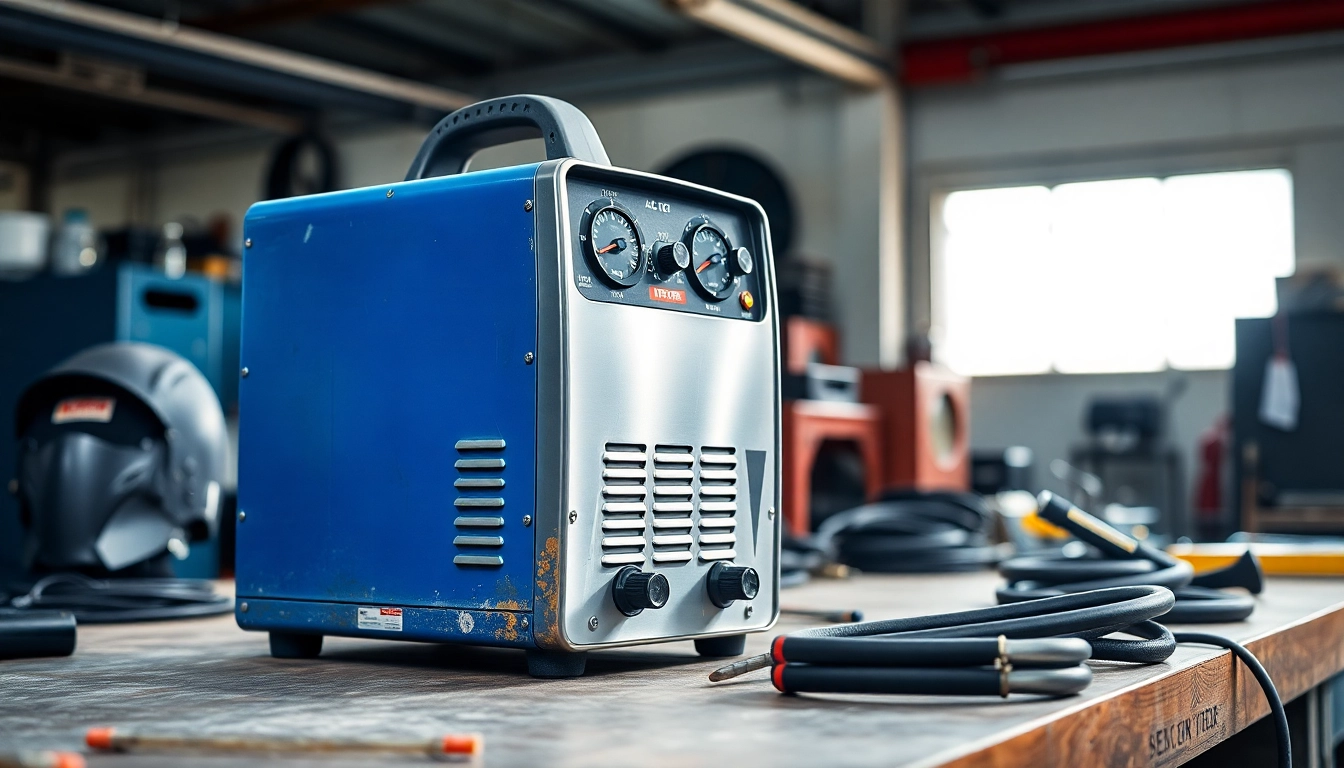Understanding AC DC TIG Welders
What is an AC DC TIG Welder?
An AC DC TIG welder is a sophisticated welding machine that can operate on both alternating current (AC) and direct current (DC). This versatility grants it the ability to weld a wide variety of metals, including aluminum, stainless steel, and carbon steel. The ac dc tig welder utilizes a process known as Tungsten Inert Gas (TIG) welding, which is renowned for its clean and precise results. It employs a non-consumable tungsten electrode to produce the weld and an inert gas, typically argon, as a shielding agent to protect the weld area from oxidation.
Key Benefits of AC DC TIG Welding
AC DC TIG welding offers several distinct advantages:
- Versatility: The ability to switch between AC and DC makes these welders suitable for different materials. AC is commonly used for aluminum and magnesium, while DC is ideal for ferrous metals.
- Precision: TIG welding provides a high degree of control over the weld pool, resulting in cleaner, more aesthetic welds.
- Strong welds: The process produces strong, durable joints, making it ideal for applications that require structural integrity.
- Less clean-up: Since the process doesn’t use filler material as commonly as MIG welding, it often results in less spatter, which means less post-weld cleanup.
Common Applications for AC DC TIG Welders
AC DC TIG welders are utilized in a variety of professional and industrial applications. Common uses include:
- Aerospace: For welding lightweight materials with critical tolerances.
- Automotive: Employed to fabricate and repair components, particularly on high-end vehicles.
- Artistic welding: Artists use TIG welding for metal sculptures due to the high-quality finish it produces.
- Manufacturing: Production of components in industries that require precise parts.
Choosing the Right AC DC TIG Welder
Factors to Consider When Buying
Purchasing an AC DC TIG welder is a significant investment, and several factors should be evaluated before making a decision:
- Welding Thickness: Different welders can handle varying thicknesses, so ensure your choice matches your typical project requirements.
- Duty Cycle: Measured in percentage, duty cycle refers to how long a welder can operate before overheating. Higher duty cycles are ideal for prolonged welding tasks.
- Portability: Consider how often and where you’ll be using the welder. A lightweight, compact model may be beneficial for fieldwork.
- Ease of Use: Some machines come with advanced features that might complicate their use; find a balance that suits your skill level.
- Brand Reputation: Invest in reputable brands known for their durability, customer support, and warranty.
Best Features for Pros and DIYers
For professional and DIY enthusiasts, certain features stand out:
- AC/DC Capability: This feature provides the flexibility to work with various alloys.
- HF Start: High-frequency start allows for a clean and quick arc start, critical for precision welding.
- Foot Pedal Control: Offers better control over the amperage during the welding process.
- Digital Display: A clear readout for settings is essential for maintaining accuracy.
- Multi-Function Capabilities: Some models integrate features for both TIG and Stick welding, adding versatility.
Comparison of Top Brands
When considering which AC DC TIG welder to buy, comparing brands can help you identify the right fit:
- Lincoln Electric: Offers models such as the Aspect 230 which is known for its reliability and strong performance in critical applications.
- Miller Electric: The Syncrowave series is favored for its efficiency and robust build, suitable for heavy-duty use.
- Everlast: Known for producing quality, affordable welders like the PowerTIG series that offer significant value for both hobbyists and professionals.
- PrimeWeld: Offers accessories bundled with their machines, adding value, particularly for first-time buyers.
Setting Up Your AC DC TIG Welder
Initial Setup and Assembly
Setting up your AC DC TIG welder requires careful attention to detail:
- Read the manufacturer’s manual thoroughly to understand specific assembly instructions.
- Position the welder in a well-ventilated area, away from flammable materials, ensuring access to power outlets.
- Connect the Argon gas supply, checking for leaks in the hoses and connections.
- Install the tungsten electrode and insert it into the holder securely.
- Set the polarity according to the material you will be welding.
Essential Accessories and Supplies
To ensure optimal performance, equip yourself with these essential accessories:
- Welding Gloves: Protect your hands from heat and sparks.
- Welding Helmet: A proper helmet with the correct shade is vital for eye protection.
- Filler Rods: Choose the right type based on the material you are working with.
- Gas Cylinder: Ensure you have a full cylinder for argon shielding gas.
- Work Clamp: A quality ground clamp is essential for safety and effective welding.
Safety Precautions to Take
Safety should be your top priority while welding. Following these precautions can prevent accidents and injuries:
- Always wear protective gear, including gloves, clothing, and a helmet.
- Ensure that your workspace is clean and free of flammable materials.
- Be aware of your surroundings and ensure adequate ventilation to avoid fume inhalation.
- Never work on live electrical systems; always disconnect the power source before maintenance.
- Keep a fire extinguisher close by in case of emergencies.
Operating an AC DC TIG Welder
Basic Operating Techniques
Operating an AC DC TIG welder can be broken down into a few basic techniques:
- Set the machine to the correct amperage based on your material thickness.
- Hold the tungsten at a 15-degree angle, maintaining a consistent arc length.
- Move the torch smoothly in a steady motion to create a uniform bead.
- Utilize filler metal as necessary by introducing it to the leading edge of the molten pool.
- Practice on scrap material before moving to your actual project.
Advanced Welding Techniques
As you gain confidence, consider incorporating advanced welding techniques:
- Weaving: A method used for wider joints to distribute heat evenly.
- Pulsed Welding: Alternating between high and low current helps control heat input and reduces distortion.
- Stacked Dimes Technique: A skillful way to create aesthetically pleasing welds that resemble a series of stacked coins.
- Multi-pass Welding: Using multiple layers to build up weld strength where necessary.
Troubleshooting Common Issues
Welding, even with the best equipment, can come with challenges. Here are some common issues and solutions:
- Inconsistent Arc: May be caused by dirty or worn tungsten, or incorrect settings. Check and replace consumables as needed.
- Excessive Spatter: Often indicates incorrect gas flow or amperage. Adjust settings accordingly.
- Poor Penetration: This can be fixed by increasing the amperage or adjusting travel speed.
- Contaminated Welds: Usually a result of oil or rust on base materials. Clean surfaces thoroughly before welding.
Maintenance and Care for Your Welder
Daily and Weekly Maintenance Tips
Regular maintenance is crucial for the longevity of your AC DC TIG welder:
- Check for gas leaks and ensure connections are tightly sealed.
- Inspect the tungsten electrode and replace it if it appears worn or contaminated.
- Clean the welder regularly to prevent dust build-up, particularly near cooling fans.
- Ensure that the cables are in good condition and check for wear.
- Monthly, examine all connections and joints for effective operation.
Replacing Consumables
Consumables in TIG welding include tungsten electrodes and gas lenses, which will need to be replaced periodically:
- Tungsten Electrodes: Replace when they become too short, brittle, or contaminated. Choice of electrode type can affect performance.
- Gas Lenses: These should be replaced if they show signs of damage or if the shielding gas flow seems inadequate.
- Filler Rods: Monitor the quantity and type, ensuring you have the right match for the materials being welded.
Extending the Life of Your AC DC TIG Welder
To maximize the lifespan of your welder, consider these strategies:
- Store the machine in a dry, cool place when not in use to prevent corrosion.
- Avoid overloading the machine beyond its duty cycle specification.
- Use it within the manufacturer’s recommended guidelines regarding materials and applications.
- Regularly calibrate settings to match the welding requirements, preserving efficiency and performance.


